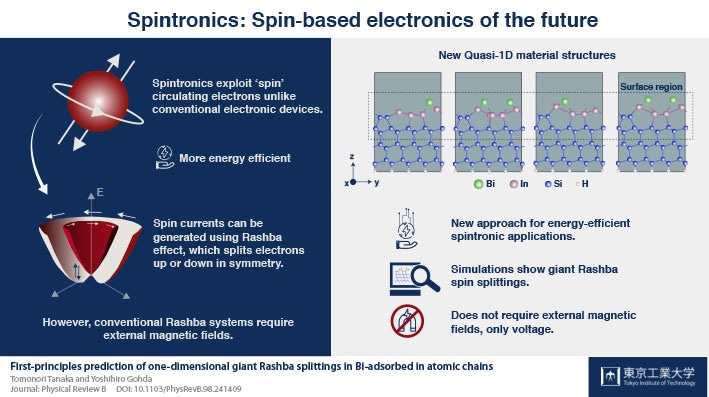Dec 28 2018
Researchers at Tokyo Tech have come up with innovative quasi-1D materials for prospective spintronic applications, an upcoming technology that involves making use of the spin of electrons. They carried out simulations to exhibit the spin properties of these materials and described the mechanisms behind their behavior.
 First-principles prediction of one-dimensional giant Rashba splittings. (Image credit: Yoshihiro Gohda, Tokyo Institute of Technology)
First-principles prediction of one-dimensional giant Rashba splittings. (Image credit: Yoshihiro Gohda, Tokyo Institute of Technology)
Traditional electronics is based on the electron movement and is chiefly related to their electric charge; sadly, researchers are close to attaining the physical limits for enhancing electronic devices. Yet, electrons possess another intrinsic quantum-physical property known as “spin,” which can be considered as a kind of angular momentum and can be either “up” or “down.” In contrast to traditional electronic devices that do not utilize the spin of the electrons that they make use of, spintronics is an area of research in which the spin of the conducting electrons is critical. “Spin currents” can be exploited to achieve serious advancements in performance as well as innovative applications.
Since spintronics sounds rather promising, scientists have been making efforts to find convenient methods for producing spin currents with material structures that have electrons with desirable spin properties. The Rashba-Bychkov effect (or simply Rashba effect), where spin-up and spin-down electrons are split up due to breakings in symmetry, could prospectively be used for this purpose.
Two scientists from Tokyo Institute of Technology, including Associate Professor Yoshihiro Gohda, have come up with an innovative mechanism for producing a spin current without energy loss from a series of simulations for innovative quasi-1D materials based on bismuth-adsorbed indium that present a giant Rashba effect.
Our mechanism is suitable for spintronic applications, having an advantage that it does not require an external magnetic field to generate nondissipative spin current.
Yoshihiro Gohda, Associate Professor, Tokyo Institute of Technology.
This benefit would simplify prospective spintronic devices and would facilitate further miniaturization.
Based on these materials, the scientists performed simulations to show that the Rashba effect in the materials can be huge and only needs the application of a specific voltage to produce spin currents. They compared the Rashba effect of multiple variations of these materials and offered descriptions for the observed differences in the spin properties of the materials and a guide for exploration of further materials.
Studies such as this are highly significant as radically innovative technologies are needed to further enhance electronic devices and reach far beyond their existing physical limits.
Our study should be important for energy-efficient spintronic applications and stimulating further exploration of different 1D Rashba systems.
Yoshihiro Gohda, Associate Professor, Tokyo Institute of Technology.
Right from faster memories to the latest quantum computers, the advantages of better insights into Rashba systems and their use will definitely have huge implications.